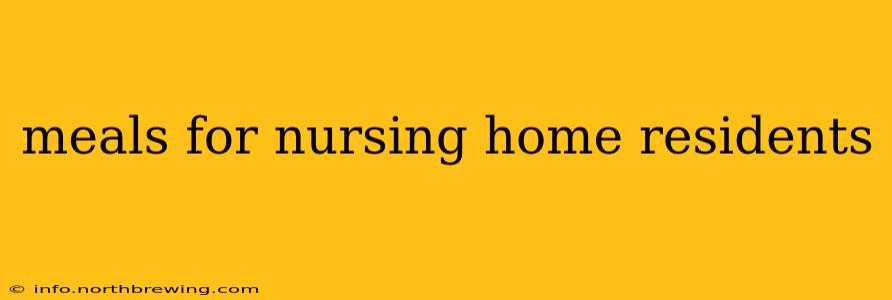Providing nutritious and enjoyable meals for nursing home residents is a crucial aspect of their overall well-being. This isn't simply about sustenance; it's about maintaining residents' health, dignity, and quality of life. This comprehensive guide delves into the complexities of meal planning for this vulnerable population, addressing dietary needs, preferences, and the challenges involved in providing optimal nutrition.
What are the Nutritional Needs of Nursing Home Residents?
Nursing home residents often face unique nutritional challenges. Many have underlying health conditions like diabetes, heart disease, or swallowing difficulties (dysphagia), requiring specialized diets. Others may experience decreased appetite, reduced mobility, or cognitive impairment affecting their eating habits. Therefore, meal planning must be highly individualized and consider:
- Age-related changes: Older adults often require higher protein intake to maintain muscle mass and prevent frailty. They may also need more vitamin D and calcium for bone health.
- Medical conditions: Diets must be tailored to manage specific conditions. For example, diabetic residents need controlled carbohydrate intake, while those with heart disease may require low-sodium meals.
- Individual preferences: Respecting residents' food preferences is essential to encourage good nutrition. Offering choices and incorporating familiar flavors can significantly improve appetite and intake.
- Swallowing difficulties (dysphagia): Residents with dysphagia require modified textures, such as pureed or thickened liquids, to prevent choking and aspiration pneumonia.
What are Common Dietary Restrictions in Nursing Homes?
Nursing homes frequently cater to a diverse range of dietary needs, often including:
- Diabetic diets: Focus on managing blood sugar levels through controlled carbohydrate intake.
- Low-sodium diets: Reduce sodium intake to manage hypertension and heart conditions.
- Pureed diets: For residents with dysphagia, offering foods that have been blended to a smooth consistency.
- Mechanical soft diets: Foods are easily chewed and swallowed, avoiding tough or chewy textures.
- Cardiac diets: Low in saturated fat and cholesterol to support heart health.
- Renal diets: Restricting phosphorus, potassium, and sodium for residents with kidney disease.
How are Meals Prepared in Nursing Homes?
Meal preparation in nursing homes follows strict guidelines to ensure food safety and nutritional adequacy. This usually involves:
- Large-scale food preparation: Meals are often prepared in bulk using industrial kitchen equipment.
- Strict hygiene protocols: Rigorous sanitation practices are crucial to prevent foodborne illnesses.
- Nutritional analysis: Dieticians or nutritionists usually oversee meal planning to ensure nutritional balance.
- Special dietary accommodations: Meals are customized based on individual resident needs and preferences.
- Food service staff: Trained personnel carefully serve and monitor residents' food intake.
What Types of Meals are Served in Nursing Homes?
The types of meals served vary greatly depending on the facility, resident needs, and available resources. However, most nursing homes aim for a balanced menu including:
- Breakfast: Cereals, eggs, toast, fruits, yogurt.
- Lunch: Sandwiches, salads, soups, pasta dishes.
- Dinner: Meat, poultry, fish, vegetables, potatoes, rice.
- Snacks: Fruits, yogurt, pudding, crackers.
How Can Families Participate in Meal Planning for Their Loved Ones?
Family involvement can significantly enhance the dining experience for residents. Many nursing homes encourage:
- Discussions with dieticians: Families can discuss their loved one's dietary preferences and restrictions.
- Food preference surveys: Some facilities regularly assess residents' food preferences.
- Special occasion meals: Families may request special meals for birthdays or holidays.
- Bringing in favorite treats (with facility approval): This can offer a sense of familiarity and comfort.
How Can I Ensure My Loved One is Getting Enough to Eat?
Monitoring your loved one's food intake is crucial, especially if they have decreased appetite or swallowing difficulties. Observe their eating habits and communicate any concerns to the nursing home staff, including:
- Appetite changes: Report any significant decrease in appetite or changes in eating habits.
- Weight loss: Unexplained weight loss requires immediate attention.
- Swallowing problems: Report any difficulty swallowing or choking episodes.
- Food preferences: Share information about your loved one's preferred foods and textures.
This guide offers a comprehensive overview of meals for nursing home residents. Remember that individualized care is paramount, and open communication between families, staff, and healthcare professionals is essential to ensure residents receive the optimal nutrition they need to thrive.
